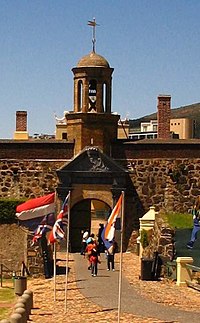Cape Town Castle
| Castle of Good Hope | |
|---|---|
| South Africa | |

Gateway to the Castle of Good Hope
|
|
| Coordinates | 33°55′33″S 18°25′40″E / 33.9259°S 18.4278°ECoordinates: 33°55′33″S 18°25′40″E / 33.9259°S 18.4278°E |
| Type | Bastion fort |
| Site information | |
| Controlled by |
|
| Open to the public |
Yes |
| Site history | |
| Built | 1666–1679 |
| Battles/wars | Second Boer War |
The Castle of Good Hope (Dutch: Kasteel de Goede Hoop; Afrikaans: Kasteel van Goeie Hoop) is a bastion fort built in the 17th century in Cape Town, South Africa. Originally located on the coastline of Table Bay, following land reclamation the fort is now located inland. In 1936 the Castle was declared a historical monument (now a provincial heritage site) and following restorations in the 1980s it is considered the best preserved example of a Dutch East India Company fort.
Built by the Dutch East India Company between 1666 and 1679, the Castle is the oldest existing colonial building in South Africa. It replaced an older fort called the Fort de Goede Hoop which was constructed from clay and timber and built by Jan van Riebeeck upon his arrival at the Cape of Good Hope in 1652. Two redoubts, Redoubt Kyckuit (Lookout) and Redoubt Duijnhoop (Duneheap) were built at the mouth of the Salt River in 1654. The purpose of the Dutch settlement in the Cape was to act as a replenishment station for ships passing the treacherous coast around the Cape on long voyages between the Netherlands and the Dutch East Indies (now Indonesia).
During 1664, tensions between Britain and the Netherlands rose amid rumours of war. That same year, Commander Zacharias Wagenaer, successor to Jan van Riebeeck, was instructed by Commissioner Isbrand Goske to build a pentagonal fortress out of stone. The first stone was laid on 2 January 1666. Work was interrupted frequently because the Dutch East India Company was reluctant to spend money on the project. On 26 April 1679, the five bastions were named after the main titles of William III of Orange-Nassau: Leerdam to the west, with Buuren, Katzenellenbogen, Nassau, and Oranje clockwise from it.
...
Wikipedia

